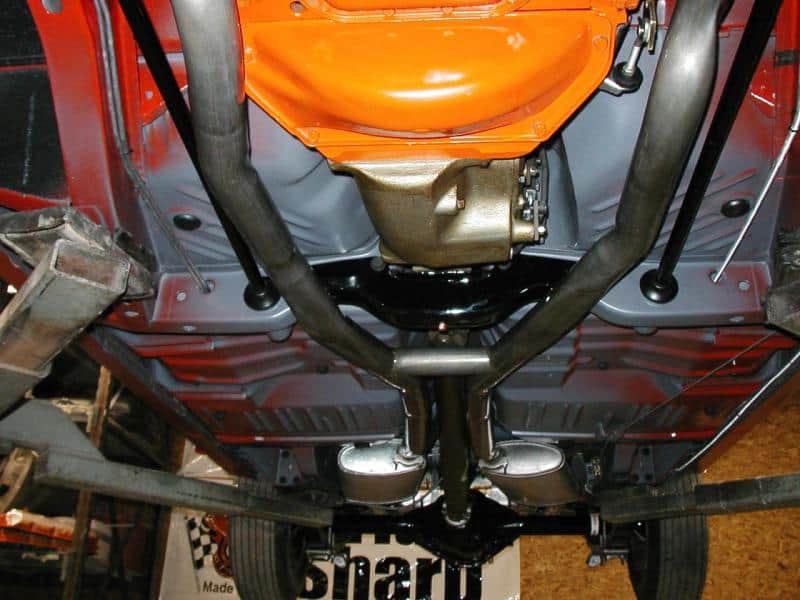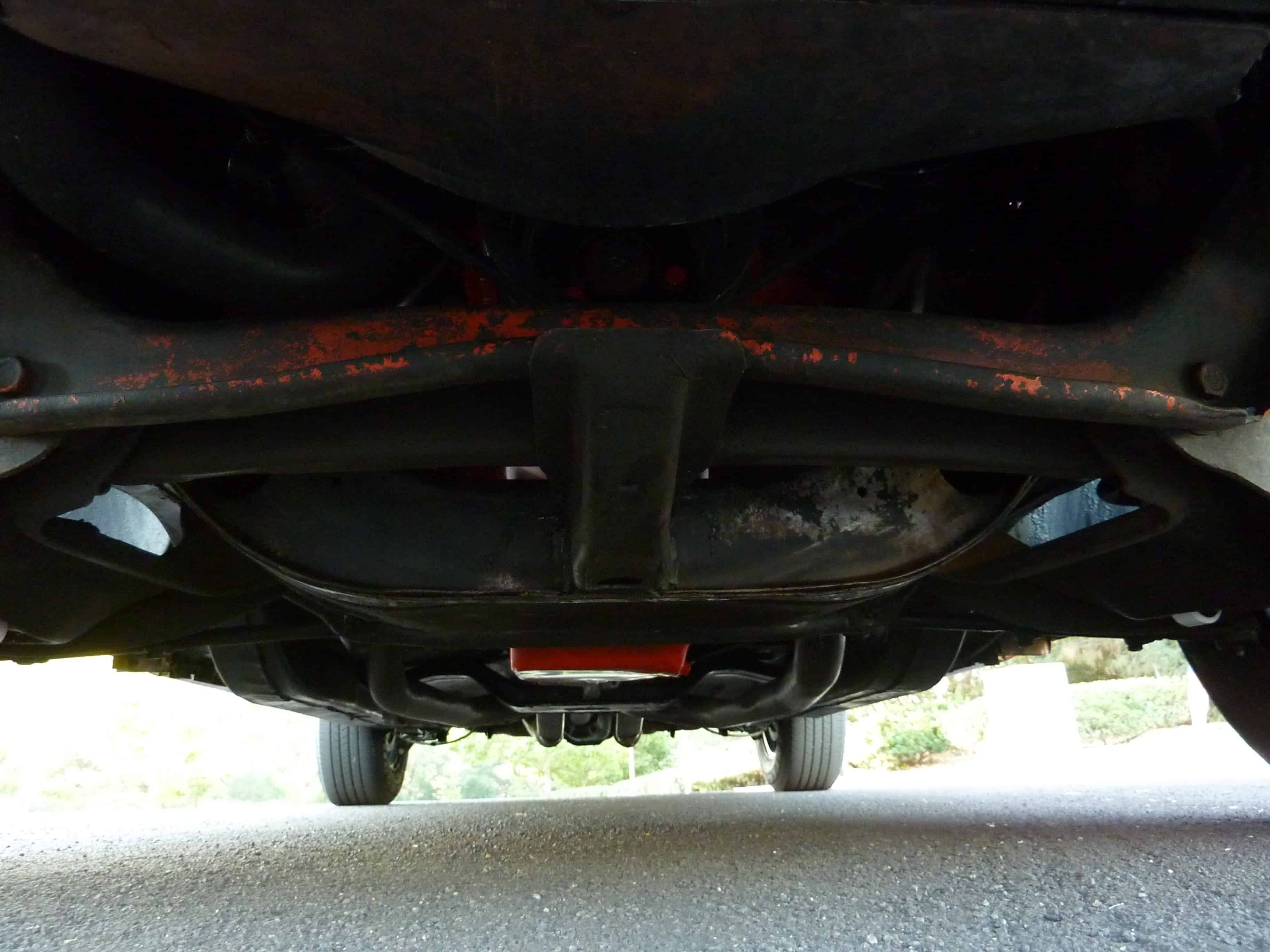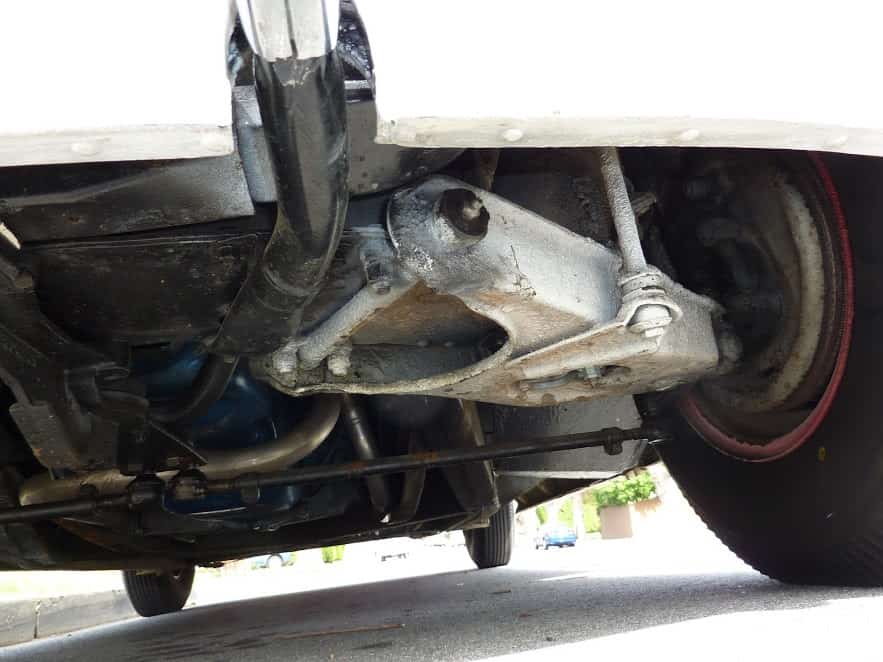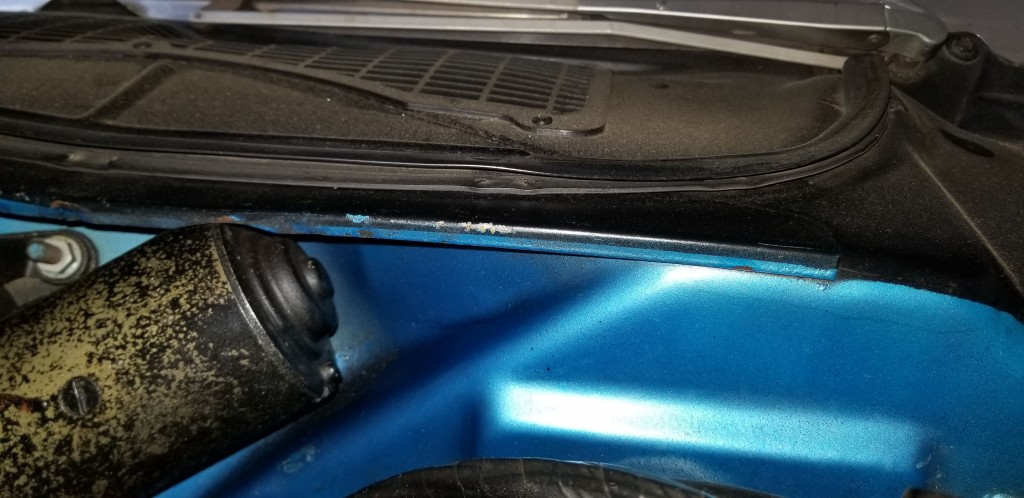UNDERSTANDING FACTORY OVERSPRAY
WHAT IS AND WHAT ISN’T?
Author: Andre Clemente, Founder of New Old Cars, LLC ©
About the author
Last updated: April 23, 2020
TAP IMAGE TO REVEAL TEXT
We’ve all seen it. We’ve all heard it. You drive hundreds of miles to look at a 35 year old “survivor” car that is claimed to be wearing it’s original paint. You meet the seller, who opens the garage and removes the car cover, revealing the beautiful single stage lacquer finish. You open the door to an interior that has just the right amount of patina and old car smell. Then you get inside and roll it out into the sunlight, where you give it a full visual.
As pretty as the exterior looks, its now time to get on your hands and knees to look underneath the car. You squint, shining your flashlight past the dirt and grime while looking for rust. Taking a closer look, you notice some body color overspray on the control arms and bushings. The seller, who knows exactly what you’re looking at, says without hesitation: “oh, that’s factory overspray. Back in the day, these cars were painted by hand”.
Oh, boy…
Here we go…
Enough is enough. The term is thrown around far too often without any deep understanding of the subject, and it needs to stop. As part of NOC’s campaign to educate the collector car community on all things paint, this article will teach you how to differentiate factory overspray from an aftermarket re-spray. No more wondering, no more guesswork. And more importantly … no more overpaying for a car you thought had original paint.
Thankfully, factory overspray became a rare occurrence once paint shops transitioned to electrostatic bell cup sprayers and full body e-dipping techniques. Unfortunately, overspray was very common prior to the mid 70’s, and it is a very misunderstood subject.
In order to understand whether or not you’re looking at “factory overspray”, you need to know how the car in question was painted by the factory. Watch any of those old assembly plant documentaries, of any make, whether from the 60’s or late 2000’s, and you’ll notice something consistent with every carmaker’s procedure in the paint shop:
A CAR IS PAINTED AS A BARE SHELL BEFORE IT IS ASSEMBLED
No suspension or rear end is attached. No gas tank. No interior trim pieces or glass. No stickers or labels. No door latches. Not even side mirrors.
This means that if you see any overspray on these components (including the hardware that holds them), it was not done by the factory.
Let’s look at the underside shot of this 1954 Corvette, for example. If the seller of this car tells you the overspray on the control arm is “factory”, you can correct him by explaining the control arm was installed after the car was painted, and therefore it shouldn’t have a spec of white paint on it.
This is also true for exterior add-ons like vent inserts, scoops, rear wings and spoilers – these are usually painted off site, as their composite materials can’t handle the high baking temperatures that the metal body sees (they also require a different application process). There should be no masking lines or overspray around these items.
But what about the genuine factory overspray that you see people trying so hard to replicate in magazines, articles, forums, and restoration guides? Where would it appear?
OVERSPRAY UNDERNEATH THE CAR

All cars of this era had primered undersides (the exposed grey color), yet not all of them received undercoating. In some cases, buyers had the option to forgo the coating, presumably to save weight and money (these were drag racers and track warriors after all). Notice how the overspray is only located on the physical body of the car. Everything from the brake lines, exhaust, crossmember, body bushings, and plugs are untouched. That is because all of these items were installed after the car was painted.
The reality is that the location of factory overspray largely depends on the construction: is the car a unibody or a body-on-frame vehicle? A unibody will see overspray on the subframe rails, while a body-on-frame vehicle will never have a spec of overspray on the frame.
This is because the body is always painted separately from the frame (if it were painted together, then the areas between the frame and body wouldn’t receive any coverage, and it would rust). The body shell is suspended on a conveyor while moving through the paint shop, receiving the appropriate rust proofing, primer, and lacquer topcoat. The frame is painted and assembled as a (mostly) complete rolling chassis (including engine and transmission) at a separate location. Once finished, the body is carefully joined to the frame via an overhead conveyor. At this time, all parts are put on that haven’t been installed yet, such as the front clip.
This GM Fisher Body assembly plant video shows this exact procedure (starting around the 16 min mark). In this particular video, the body shell is completed at a Fisher Body plant, then sent to a Chevrolet assembly plant for final assembly.
Regardless of the body construction, factory overspray of body color paint will only be visible on places like the floor pans, cowl, transmission tunnel opening, wheel wells, underside of trunk floor, and lower backside of the quarter panels. These are the unpainted areas that are easily accessible for overspray to land on. Keep in mind, the overspray under the trunk floor is usually completely hidden by the gas tank. Gas tanks are installed after the car is painted, and should not have a spec of paint on them!
OVERSPRAY BY HAND APPLICATION VS AUTOMATED RECIPROCATORS
For European cars, the 1960’s witnessed the slow transition to automated spray guns. However, these early systems were not the 6-axis robots that you see today, which means they could only apply paint on easy to reach areas (like the top of the car and the sides). It would be decades until robotic sprayers gain the capability to do everything on their own, so hand application was still needed for hard to reach areas (so much so that it’s still common in modern car production). Plus, while these early reciprocating guns had a better transfer rate than period hand guns, it was still poor by todays standards, as there was no electrical attraction between the paint and body. As a result, overspray was still an issue.
On the contrary, the Big Three were a little late to the game, and American cars were primed and painted almost exclusively by hand throughout the entire 60’s – the few assembly plants that implemented automation did so toward the end of the decade. All bodies were dipped in rust-proof coating prior to application.
TAP IMAGES TO REVEAL TEXT
PLANT VARIANCE: Understand that paint technology could vary between plants of the same manufacturer at any given time. Just because one Ford assembly plant was painting entirely by hand in 1974, it doesn’t mean ALL Ford plants were painting entirely by hand in 1974. Implementing automated sprayers on the production line was costly, so it wasn’t applied to all assembly plants at once. Usually the technology is tested at one or two assembly plants first, and the quality and cost savings are analyzed. If it proves satisfactory, the technology slowly gets implemented within the remaining plants (or entirely new paint shops are built). Research what plant your car was produced at to be sure if it was painted by machine or exclusively by hand.
UNDERCOATING
It’s important to note that the underside of cars in this era were never deliberately painted body color – it simply was victim to an excessive amount of overspray. The amount varied greatly per model due to many variables of the pre-1970’s paint process.
TAP IMAGE TO REVEAL TEXT
This would cover up most of the overspray (if not all, depending on the extent of the coverage) underneath the car. Cars that didn’t have this undercoating meant they had an excessive amount of visible overspray underneath (which stuck to the primer like a magnet), like the Daytona above.
European cars like the Mercedes W113 Pagoda saw undercoating application before paint was applied to the body. This meant that body color overspray would sit on top of this PVC coating (known as Schutz). Of course, as the car gets driven through the decades, road grime and dirt can get caked onto the underside, hiding most of the overspray.
Now when your average body shop repaints a panel for repair, they obviously don’t mask the underside of the car, resulting in the overspray shown in the photos below. You can differentiate this from factory overspray by noting what the overspray is attached to. In both photos, the paint is resting on parts that are installed after the shell is painted:


If you get a stubborn seller who insists this overspray is factory, take your finger and wipe the overspray firmly with your finger. If it comes right off, it’s because the paint is sitting on top of dirt, mud, and road grime from years of driving. Why would the “factory overspray” be sitting on top of road filth? True original overspray would be underneath it, not on top of it. Another thing to do is to look for other signs of paintwork – there will always be visual indicators of a respray throughout the car – you just need to know where to look!
OVERSPRAY FROM BLACKOUT TREATMENT
TAP IMAGE TO REVEAL TEXT
WATCH HOW THEY DID IT!
If you truly want to learn about your car’s factory paint process, take the time to watch old assembly plant documentaries dating back to the year your car was born (if you can find it!). You will see exactly how a car was assembled during that time period, including the order in which things were installed and the techniques used (or, not used…) to minimize paint defects. Obviously certain cars can vary drastically from the norm (Corvettes, Porsches, unibody cars vs full frame cars, etc), and the more you watch, the greater your understanding of the factory paint process becomes.
You can even go on concours show websites (or any shows that judge cars of your make and model) and read the judging guidelines for any of the “originality” classes, such as the preservation class. They can sometimes be very specific in what they look for, especially in regards to paint. Also, some factory workers who are still around today write about their memories in dedicated forums or articles. Their first hand experience of the process is incredibly valuable to the collector car community – imagine talking to the guy who possibly laid hands on your car while it was built at the plant!
One last thing: as tempting as it may be, it’s not always safe to rely on low mileage examples to use as comparison for originality sake. Cars can receive paintwork before they even sell off the lot (from damage during transport, etc), so that “1500 original mile” Corvette could actually have overspray underneath the car from a previous repair. The key is to know how to inspect for paintwork, and if you have the ability, look for consistency between cars. If you consistently see overspray in the same spot on multiple vehicles of the same model/origin, you can safely bet that this was done by the factory. After all, what are the odds of overspray from a bodyshop repair appearing in the same exact location on multiple vehicles?
Author:
Andre Clemente, Founder of New Old Cars, LLC ©
Article last updated: April 23, 2020
About the Author: Andre Clemente, a member of the Society of Automotive Historians (SAH), has spent over 12 years in the business of buying and selling cars – half of those years were dedicated to the classic car/sports car business. As an automotive paint fanatic, Andre has been hyper-focused on learning paint correction and inspecting automotive paintwork, working alongside veteran dealers, brokers, and a licensed Concours judge in the process. Years of real-world practice and application gave him the experience to identify inaccuracies and myths that are widely accepted when authenticating a vehicle’s paint job. Rather than keep his knowledge as a trade secret, he has decided to share the research and insider details he’s learned to help educate the collector car community, and ultimately shine a brighter light on the cars truly wearing their original paint.
Other articles you may enjoy:
How To Confirm Original Paint On Any Car
Those Paint Defects Most Likely Aren’t From The Factory
Orange Peel: Why Your New Car’s Paint May Look So Bad
What A Paint Thickness Gauge Really Tells You
Why Are Bumpers a Different Shade from The Rest of The Car?
…and more, in the Tech section!
Additional Article Sources:
Paint Robots In The Automotive Industry – Process and Cost Optimization
written by Udo Grohmann of ABB Flexible Automation GmbH
Streitberger, Hans-Joachim, and Dössel, Karl-Friedrich. Automotive Paint and Coatings, 2nd Edition. WILEY-VCH Verlag GmBH & Co, 2008.
The History of Robotics in the Automotive Industry
Visionary Efforts by the Painting/Coating Departments of Honda’s Factories
Dodge Engineering Dealership Data Book – 7 Steps – 1972
Chrysler moves to Unibody (unit-body construction): 1960
…and many more! NOC takes incredible pride in posting only the most accurate information with the help of credible sources. Now, because some links are no longer active, not all sources are posted here. These links have been removed from the source’s website for unknown reasons. However, NOC downloads and retains all sources used to stand by every statement in this article. This is done for all articles on our website, and NOC is happy to share this information with the public. Your trust is our number one priority.






